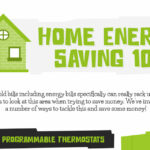If you want to maximize savings on home upgrades, rebates often offer immediate discounts, reducing your upfront costs, while tax credits provide longer-term benefits by cutting your tax bill later. Rebates give quick savings, especially for high-ticket items, but tax credits can be more valuable if you have a sizable tax liability. The best choice depends on your financial situation, and understanding both options can help you make smarter decisions—details that can boost your overall savings.
Key Takeaways
- Rebates provide immediate savings at purchase, reducing upfront costs, while tax credits offer future savings during tax season.
- Tax credits typically cover a percentage of upgrade costs, potentially up to 30%, leading to larger long-term savings if you have sufficient tax liability.
- Rebates are often easier to claim with instant discounts or quick documentation, whereas tax credits require detailed paperwork and proper filing.
- Combining rebates and tax credits maximizes total savings by lowering initial expenses and reducing tax liability later.
- The more expensive the upgrade, the greater the potential savings from both rebates and tax credits, especially when strategically coordinated.
Understanding the Basics: Rebates and Tax Credits Explained
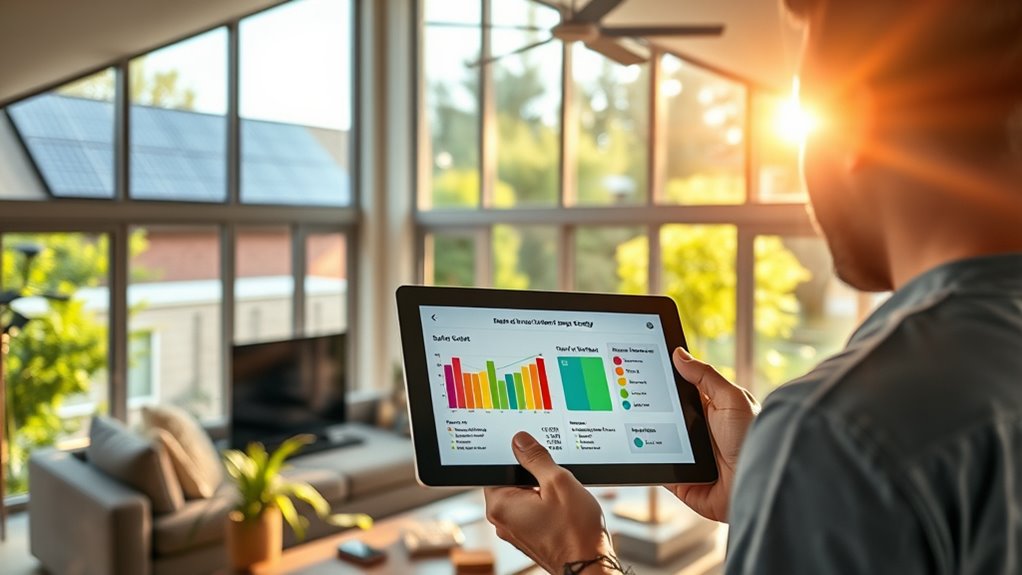
Have you ever wondered how home energy incentives work? Rebates and tax credits are two popular ways to save on energy upgrades, but they serve different purposes. Rebates are upfront discounts offered by state, tribal, or local programs, reducing your purchase price immediately. They help lower your initial out-of-pocket costs for energy-efficient products or improvements. Tax credits, on the other hand, come when you file your federal income taxes. They reduce your tax liability dollar-for-dollar, meaning you get a direct reduction on your tax bill or a bigger refund. Both incentives aim to encourage energy efficiency and reduce emissions. Rebates are typically available at the point of sale, while tax credits are claimed later on your tax return. Understanding these basics helps you plan your upgrades more effectively. Recent legislation also makes it easier to qualify for these programs and maximize your savings. Additionally, being aware of program eligibility criteria ensures you take full advantage of available incentives.
Financial Benefits: Comparing Immediate Savings and Long-term Value

Choosing between home energy rebates and tax credits depends on whether you want to see immediate savings or plan for long-term financial benefits. Rebates provide upfront discounts, lowering your purchase price right at the point of sale, which is ideal if you need quick cash flow. Tax credits, on the other hand, reduce your tax liability later, offering long-term value but delayed benefits. Here’s a quick comparison:
| Aspect | Immediate Savings | Long-term Value | Application Process |
|---|---|---|---|
| Cash Flow Impact | Upfront discounts for instant relief | Savings at tax time | Rebate applications are quick; tax credits require documentation |
| Savings Potential | Up to $14,000 in some programs | Up to 30% of upgrade costs | Rebate coverage varies by region; tax credits depend on tax liability |
| Accessibility | More universally accessible | Dependent on tax situation | Both can be combined for maximum benefit |
| Timing | Immediate | Deferred | Rebate process is quicker; tax credits, annual |
This comparison helps you decide which aligns with your financial goals. Additionally, understanding the contrast between rebates and tax credits can help optimize your incentive strategy.
Eligible Products and Projects for Incentives
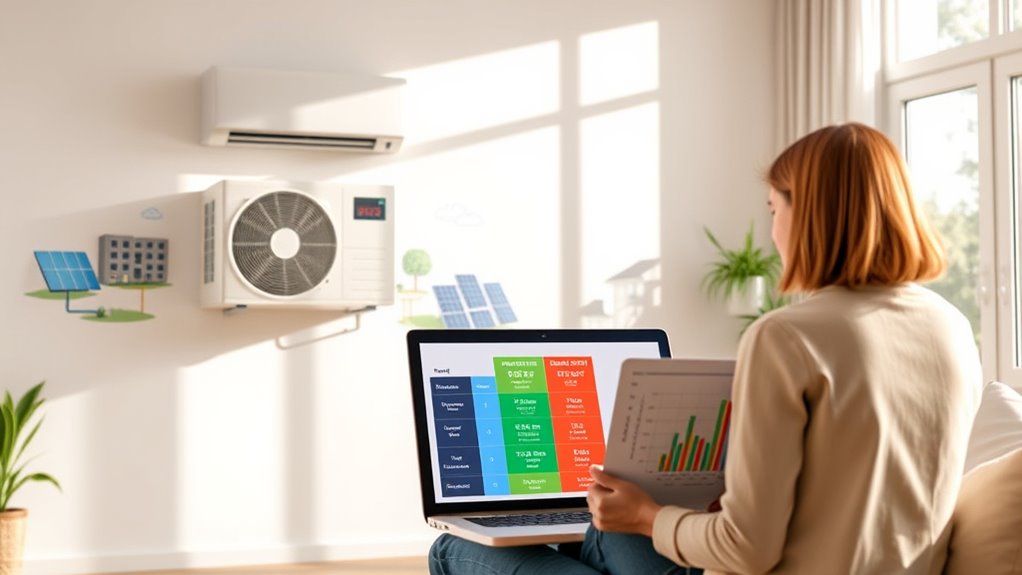
You need to know which equipment and home upgrades qualify for energy incentives. Eligible products include windows, insulation, heat pumps, and high-efficiency water heaters, among others. Understanding these options helps you maximize your savings and guarantee your projects meet the program requirements. Additionally, some upgrades like geothermal heat pumps and air sealing also qualify for significant rebates and incentives. Incorporating personal growth techniques such as mindfulness or stress management strategies can further enhance your overall well-being during home improvement projects.
Qualified Equipment Types
Eligible equipment for home energy rebates and tax credits includes a range of high-efficiency heating, cooling, and renewable energy systems. You can qualify for incentives when installing ENERGY STAR-rated heat pumps, furnaces, boilers, and water heaters that meet or exceed efficiency standards. For heat pumps, both electric and natural gas models are eligible, including split systems with indoor and outdoor components. Central air conditioners that meet the highest efficiency tiers also qualify, along with related electrical upgrades. Renewable energy systems like solar panels, wind turbines, geothermal setups, and battery storage may also be eligible if they meet federal standards. Spoilage detection methods can help ensure the safety and efficiency of the equipment you choose, maximizing your incentives.
Eligible Home Improvements
Home improvements that qualify for energy incentives include a variety of upgrades designed to boost your home’s efficiency and reduce energy costs. Energy audits, performed by certified professionals, can earn you tax credits up to $150 annually, helping identify potential savings. Renewable energy systems like solar panels, wind turbines, geothermal heat pumps, and fuel cells qualify for separate tax credits that cover equipment and installation costs. Upgrading exterior doors, windows, and skylights with Energy Star-rated products can earn credits up to $500 annually, though labor costs don’t qualify. Insulation and air sealing improvements qualify for a 30% tax credit with no dollar cap, up to $1,200 yearly. Additionally, new HVAC systems, water heaters, and heat pumps meeting efficiency standards can earn credits up to $2,000 per item. Proper management and understanding of tax credits and incentives can maximize your savings effectively.
Impact on Your Energy Bills and Home Comfort
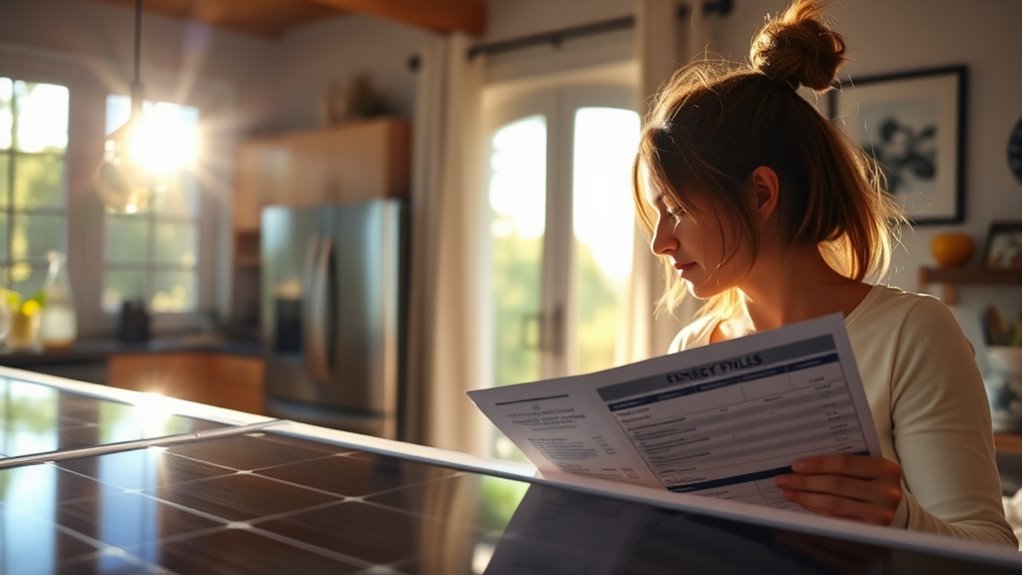
Rebates and tax credits both play a significant role in shaping your energy bills and home comfort, but they do so in different ways. Rebates offer upfront discounts, lowering your initial costs and reducing your immediate out-of-pocket expenses. This means you see savings right after purchasing energy-efficient upgrades. Tax credits, on the other hand, provide dollar-for-dollar reductions on your tax liability, saving you money after filing taxes. They don’t lower your bills directly but can free up cash through bigger refunds or lower taxes. Combining both can maximize your savings and improve home comfort. Additionally, ensuring your Ring Security Cameras are properly maintained can help maximize energy efficiency and security, further enhancing your home’s comfort and savings.
Navigating Program Availability and Application Process
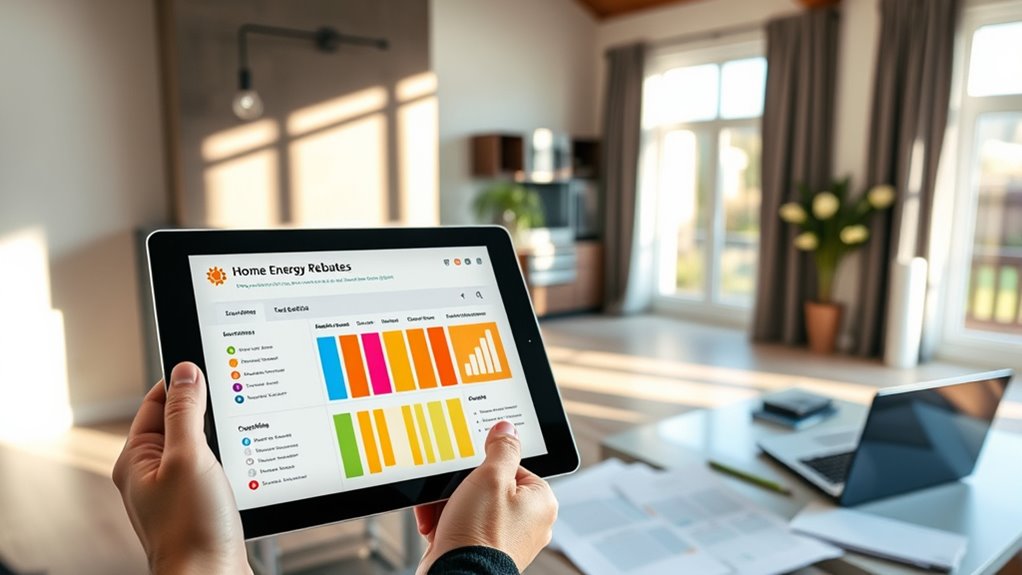
Finding your way through the availability and application process for energy efficiency programs can seem overwhelming, but understanding how to access these incentives is crucial for maximizing your savings. First, check if the programs are available in your state or region, as eligibility varies. Rebate programs usually require less paperwork; you’ll often need to submit proof of purchase and completed project documentation directly to utility companies or state agencies. Additionally, some programs provide instant discounts or rebates that can be applied directly at the point of sale, simplifying the process. Tax credits, on the other hand, involve filing specific tax forms and keeping records of expenses, with deadlines often tied to the end of the year or program expiration dates. Some programs might need pre-approval or registration before starting your project. Hiring certified professionals can help ensure compliance and smoothen the process, making it easier to claim your benefits. Program availability varies by location, so verify which incentives you qualify for before beginning your upgrades.
Strategies to Maximize Your Savings
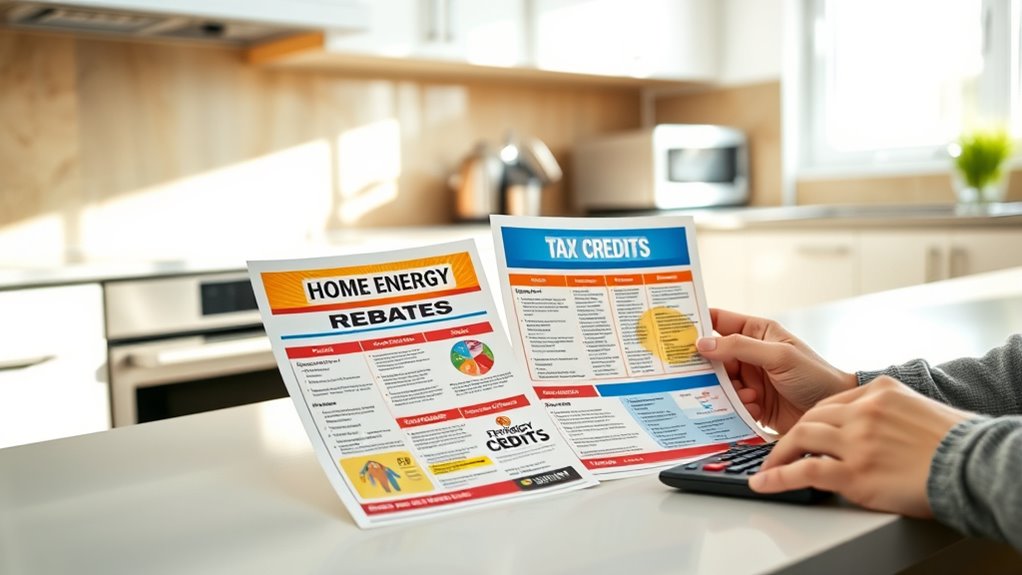
Maximizing your savings requires strategic planning to make the most of available incentives. To do this, consider timing your purchases carefully, so you can benefit from both rebates and tax credits.
- Plan your upgrades within the same tax year to maximize combined savings, and keep receipts and documentation ready for tax filing.
- Take advantage of immediate rebates to lower upfront costs, especially for high-ticket items like heat pumps or windows.
- Bundle multiple energy-efficient improvements—such as insulation, HVAC, and solar—to boost rebate eligibility and increase overall tax credits.
- Remember that rebates are received shortly after installation, providing quick financial relief, whereas tax credits are claimed when filing taxes, potentially offering larger savings over time by combining both, you can optimize your total savings.
- Additionally, reviewing energy policies can help you stay informed about new incentives or changes that could further enhance your savings.
Making the Right Choice for Your Home Energy Improvements
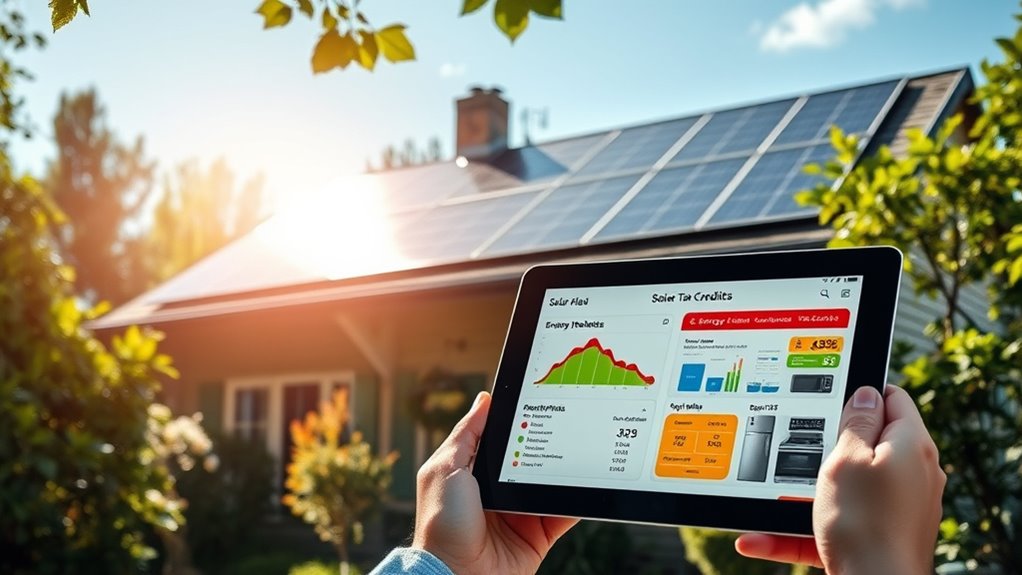
To make the best decision, you need to weigh immediate savings from rebates against future benefits from tax credits. Combining both incentives can maximize your overall savings, but timing and eligibility matter. Understanding how to align these options guarantees you get the most value from your home energy upgrades. Tax credits are claimed during tax filing and can provide a dollar-for-dollar reduction in your owed taxes, which may be more beneficial if you have a sufficient tax liability. Additionally, considering the timing of incentives can help you plan your energy improvements to optimize savings.
Evaluating Immediate vs. Future Savings
When deciding between home energy rebates and tax credits, understanding the timing of savings is essential. Rebates offer immediate financial relief at the point of purchase, reducing upfront costs with no tax filing needed. In contrast, tax credits provide future savings during tax season, lowering your federal tax bill and potentially saving you hundreds annually. To weigh your options:
- Rebates give instant discounts on products like windows or heat pumps.
- Tax credits reduce taxes owed after filing, with benefits based on a percentage of costs.
- Rebates typically have fewer eligibility restrictions, while tax credits apply nationwide.
- Being aware of juice cleanse benefits can also promote overall wellness and energy, indirectly supporting your home improvement efforts.
Choosing between them depends on your current financial situation and long-term goals. Combining both can maximize savings, but knowing when each benefits you most helps you make smarter decisions.
Combining Incentives Effectively
Combining home energy rebates and tax credits can substantially boost your savings, but doing so effectively requires careful planning. First, research local and state rebate programs to confirm what’s available for your upgrades, as these vary widely. Next, check federal tax credit eligibility and limits—such as the 30% credit on solar or heat pumps—and ensure your planned improvements qualify. Use rebates to lower initial costs, reducing the upfront investment, while planning to claim tax credits in the following tax season to maximize long-term savings. Keep in mind that rebates provide immediate cash or discounts, whereas tax credits reduce your tax liability later. By coordinating these incentives thoughtfully, you can minimize costs and maximize your home energy improvements’ financial benefits.
Frequently Asked Questions
Can I Receive Both Rebates and Tax Credits for the Same Home Upgrade?
Yes, you can usually receive both rebates and tax credits for the same home upgrade. You should claim rebates first, as they offer immediate savings, and then include the tax credits when you file your taxes. Just remember to keep all documentation and verify the upgrade qualifies for both incentives. Check the specific requirements for your region and project to maximize your benefits.
Do Rebates or Tax Credits Have Stricter Eligibility Requirements?
You wonder which has stricter eligibility rules—rebates or tax credits. Generally, rebates have more stringent requirements, focusing on income limits, residency, and specific property types like manufactured homes or renters with landlord permission. Tax credits mainly require your home to be your primary residence and product certifications. If you’re aiming for maximum flexibility, rebates often have tighter restrictions, especially for low- and moderate-income households.
How Long Do I Have to Apply for Rebates or Claim Tax Credits?
Imagine you install energy-efficient windows in March 2024. You have until the end of that year to claim your federal tax credit on your 2024 tax return, but rebates from your utility might require applying within a few months of installation. Typically, tax credits are claimed when you file taxes, while rebates often need quick applications—so check each program’s deadline to avoid missing out.
Are There Income Limits That Affect Eligibility for These Incentives?
You might wonder if income limits affect your eligibility for home energy incentives. After 2022, there are no specific income restrictions for claiming these tax credits. However, some rebates and local programs could have income or geographic requirements, so check your area’s rules. Confirm your energy-efficient products meet standards, and follow installation and reporting guidelines to qualify. Staying informed helps you maximize your savings and qualify for the most benefits.
Can I Use These Incentives for Existing Home Improvements or Only New Builds?
Did you know that rebates often provide up to $14,000 in savings? You can definitely use these incentives for existing home improvements, not just new builds. Rebate programs frequently target upgrades like HVAC systems, windows, and insulation in older homes. Just keep in mind that eligibility varies by program and location, so check the specific requirements. Retain receipts and documentation to maximize your chances of claiming these valuable incentives.
Conclusion
By understanding the differences between rebates and tax credits, you can make smarter choices for your home. Did you know that homeowners who actively pursue these incentives can save up to 30% on qualifying energy upgrades? Taking advantage of available programs not only reduces your upfront costs but also boosts your home’s efficiency and comfort. Stay informed, plan strategically, and you’ll maximize your savings while making a meaningful impact on your energy footprint.
I’m Theodore, and I love tiny houses. In fact, I’m the author of Tiny House 43, a book about tiny houses that are also tree houses. I think they’re magical places where imaginations can run wild and adventures are just waiting to happen.
While tree houses are often associated with childhood, they can be the perfect adult retreat. They offer a cozy space to relax and unwind, surrounded by nature. And since they’re typically built on stilts or raised platforms, they offer stunning views that traditional homes simply can’t match.
If you’re looking for a unique and romantic getaway, a tree house tiny house might just be the perfect option.



